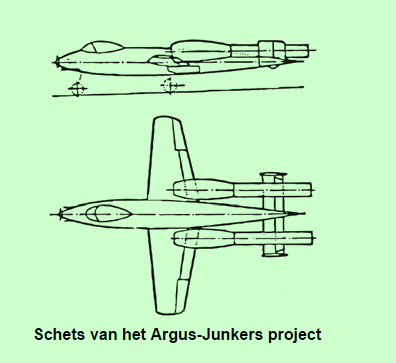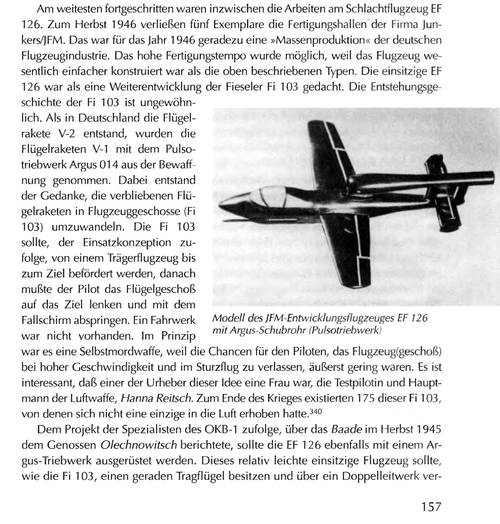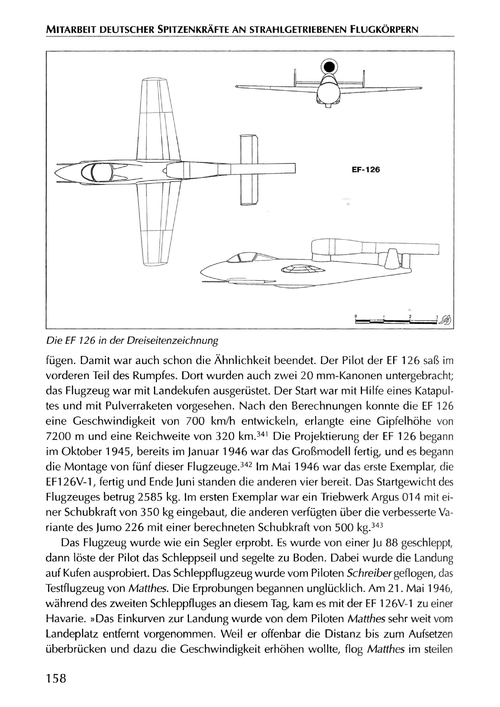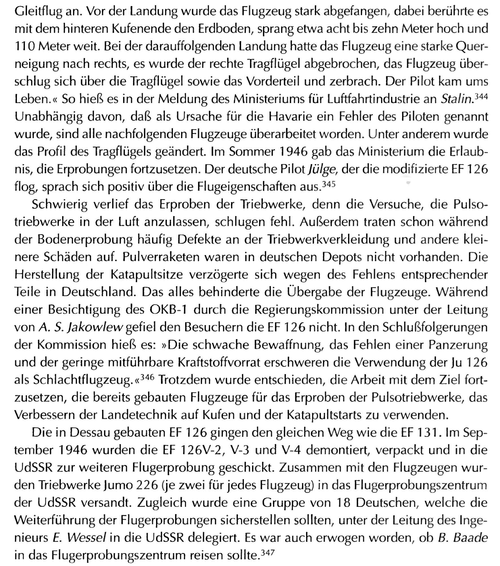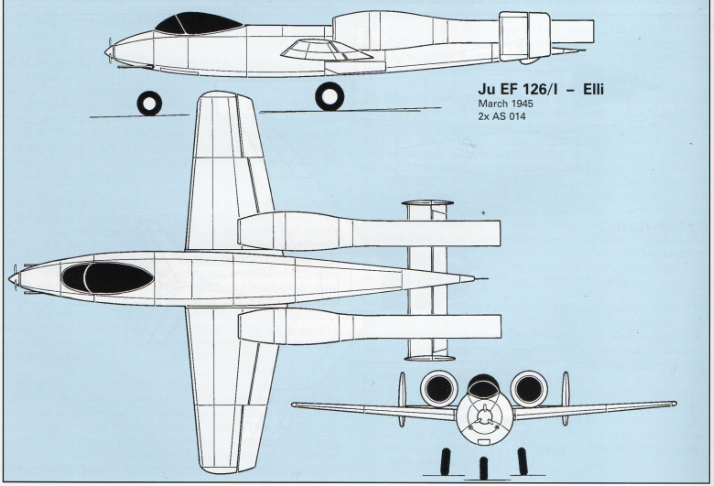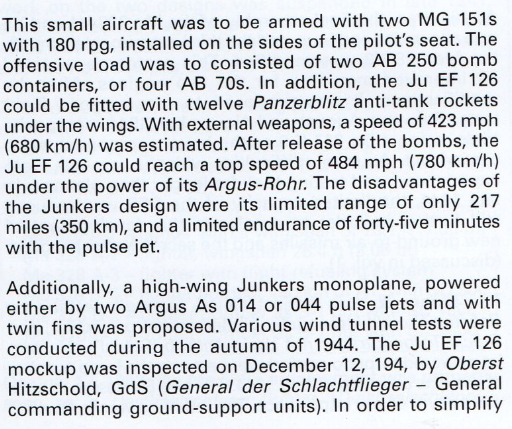Translation :
"Most advanced were the construction works on the ground attack aircraft EF 126. During autumn 1946, 5 aircraft
left the factory of Junkers/JFM. For that time, that was really a kind of "mass production" in German aviation
industry ! This speed of production was possible, because the aircraft was much simpler, than the types described
above.The single seat EF 126 was planned as a development of the Fieseler Fi 103, making her development history
unusual. When the <winged rocket> V2 was built, the <winged rocket> V1 was cancelled from further production plans.
That triggered ideas, to modify left over Fi 103. The Fi 103 was intended to be carried to the target area by an
aircraft, where the pilot took over to guide the missile onto the target and eject .
So there was no landing gear. Principally it was a suicide weapon, because chances to leave the aircraft at high speed
in the dive were minimal. It's interesting, that the creator of this idea was a woman, Hanna Reitsch, test pilot and
captain of the Luftwaffe. At the end of the war there were 175 of those Fi 103, not a single one had been flown.
According to the specialist of OKB-1, Baade reported about it to <compeer> (socialist/communist appelation) Olechnowitsch
during atumn 1945, the EF 126 should be powered by an Argus pulse jet. This relatively light, single seat aircraft should
have straight wings, like the Fi 103 and a twin tail, but that already were all similarities. The pilot was seated in the
forward part of the fuselage, the two 20 mm guns were mounted there, too. The aircraft was fitted with landing skids
Take-off should be accomplished by catapult and solid fuel rockets. Calculations predicted a speed of up to 700 km/h.
a ceiling of 7200 m and a range of 320 km. Planning for the EF 126 started in October 1945 and already in January 1946,
a full scale model was finished and the production of 5 aircraft began. The first example, EF 126V-1 was finished and at
the end of June the other four were ready. Take-off weight was 2585 kg. The first aircrat got an Argus 014 pulse jet with
a thrust of 350 kg, the other four had the improved Jumo 226 witha predicted thrust of 500 kg.
The aircraft was tested as a glider. Towed by a Ju 88, the pilot released the tow line, gliding back to earth. The towing
aircraft was flown by Pilot Schreiber, the test aircraft by pilot Matthes. Testing began with a mishap, at 21st of May 1946,
during the second launch. "Matthes had started the return to the airfield quite far away. Probably to gap the distance to
the touch down point, he tried to increase speed by flying in a deep gliding angle. Just prior to touch down, he flared and
the aircraft touched the ground with the after end of the landing skid. It jumped back to a heigt of eight to ten meters for
a distance of about 110 m. During the following landing, the right wing was sheared off, the aircraft somersaulted and broke
into parts, killing the pilot." That was the report from ministry for the aviation industry to Stalin. Though the reason was
stated as pilot's error, all other aircraft were reworked. One change amongst others was the change of the wing profile. In
summer 1946 the ministry allowed further testing and the German pilot Jülge regarded the flight characteristics as good.
Testing the pulse jet engines was difficult, because attempts to start them in the air failed. Additionally, already during
ground testing, there were defects in the engine cowlings and other minor damages. There were no solid fuel rockets in the German
depots, development of the ejection seats was delayed, because of shortage of needed parts in Germany, hindering delivery of
the aircraft. During an inspection of the OKB-1 by a governmental commission, the EF 126 didn't appeal to the visitors. In the
conclusion, the commission said "Weak armament, missing armour and the very limited amount of fuel make the use of this aircraft
as a ground attacker difficult". Nevertheless, work was kept going on , the already finished aircraft should be used for testing
pulse jet engines, landing techniques for aircraft with skids and catapult launch.
The EF 126 built in Dessau took the same way, as the EF 131. In September 1946, the EF 126V-2, V-3 and V-4 were dismantled, packed
up and sent to the Soviet Union. At the same time, a group of 18 Germans, intended to proceed with further testing, were delegated
to the SU, led by Engineer E.Wessel. It was planned, too, that B.Baade should go to the testing center."

